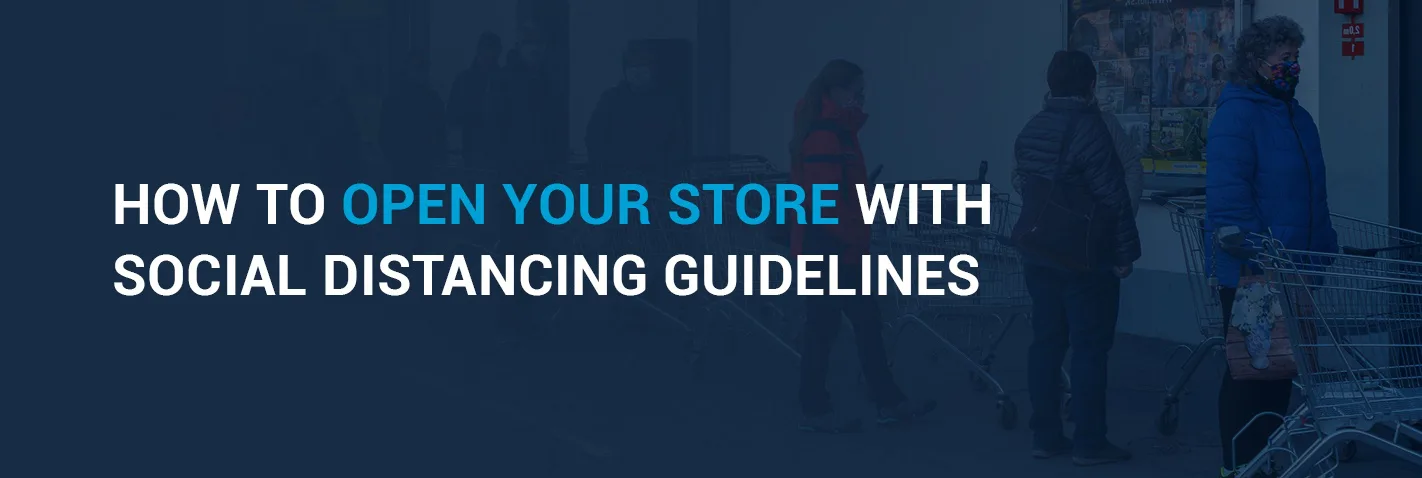

Table of Contents
If your business has shut down since the start of the current health crisis, you’re probably hoping to get back to work as soon as it’s safe. Now, as restrictions are lifted, many businesses can finally reopen. However, due to current reopening guidelines, your store or restaurant will need to operate differently than it once did.
This guide on how to keep the workplace safe from coronavirus can help you open for business safely under the current regulations.
All nonessential businesses have adjusted their operations since the COVID-19 pandemic began. Now, as states begin to ease restrictions, many companies are starting to reopen. The Centers for Disease Control and Prevention (CDC) offers recommendations for small businesses and the most up-to-date information about the disease.
While each state will develop a unique reopening strategy, the Federal Government’s Guidelines for Opening Up America Again breaks down reopening guidelines into three phases. Here’s how each stage applies to retail stores and restaurants:
Before entering Phase One, a state should meet specific criteria. Your state should have a downward trajectory of influenza and COVID-like illnesses, as well as documented cases reported for 14 days. Hospitals must have the capacity to operate without crisis care and have a robust testing program for healthcare workers.
When all these criteria are met, businesses can begin operation under Phase One guidelines, unless otherwise determined by the state government:
If a state has no evidence of a rebound and meets all criteria for Phase One a second time, employers can operate under Phase Two:
If the state doesn’t have a rebound and can satisfy the gating criteria for another 14 days, it may enter Phase Three:
Each state will have its own strategy for reopening, so your business may be subject to more regulations. In general, you should expect to keep staff and customers at least 6 feet apart, disinfect surfaces and ensure employees wash their hands often.
New guidelines call for careful procedures for social distancing and disinfection. Follow these steps to ensure you follow all new regulations and create a safe working and shopping environment:
As you assess your reopening plans, look to any federal, state and local guidelines. If you do not meet state requirements for reopening, you should not reopen. The CDC has specific recommendations for essential grocery and retail workers that can guide your operation efforts. You can also review the CDC’s restaurant and bar decision tree to decide if your business is ready to reopen.
For recommendations, support and advice specific to your industry, consult your industry associations. The National Restaurant Association® issued COVID-19 reopening guidance for restaurant operators. Likewise, the National Retail Federation® released a reopening checklist and other resources for nonessential retailers.
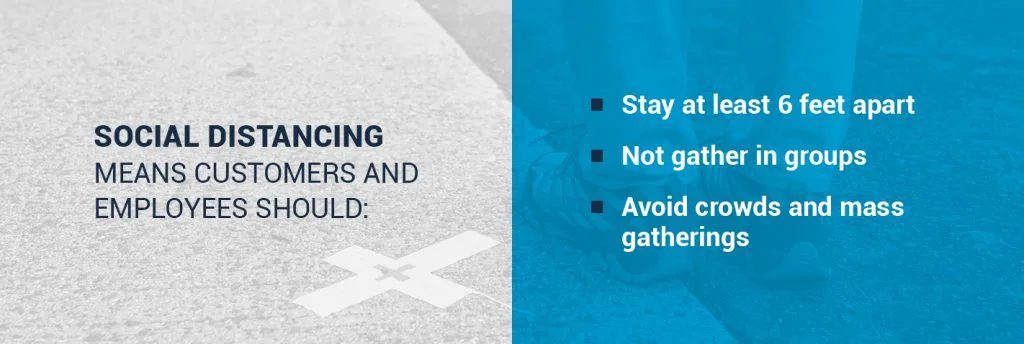
The CDC recommends social distancing measures be in place to reopen your business. Social distancing means customers and employees should:
These rules dictate measures to keep people apart. You’ll likely have to limit your capacity, which requires an accurate headcount. People-counting technology gives you a live count of those who have entered and exited the building without putting your employees in harm’s way. This information lets you know when to stop allowing new patrons to keep your capacity in check.
You may also want to use floor markers to guide people waiting to enter the building or to use the register.
Many essential retailers have limited hours to make time for frequent disinfecting. As they begin to reopen, other retailers and restaurants should expect to do the same.
The CDC offers extensive guidance on cleaning and disinfecting for reopened businesses. Any disinfection plan should follow these guidelines:
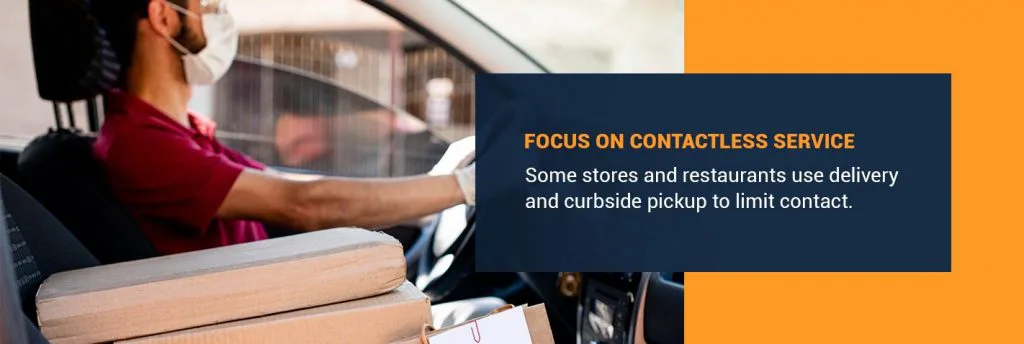
Many retailers and restaurants are using new methods to continue serving customers with limited contact. Some stores and restaurants use delivery and curbside pickup to limit contact. These methods allow you to keep capacities low within your store and continue to serve many customers. Also, touchless or online payment can reduce touchpoints between customers and staff.
Whenever possible, PPE can help your employees and customers stay safe. If it’s not feasible to provide masks to employees, encourage staff to wear cloth masks. Be sure to provide hand sanitizer and keep the bathrooms stocked with soap. The CDC recommends wearing gloves when using disinfectants, so it is vital to keep these in stock.
As you reopen your business, your employees will have to take on new duties, such as disinfecting surfaces and enforcing social distancing. As new tasks become necessary, make sure your staff understands new rules and expectations and is equipped to follow them. Also, consider automating your capacity counting with a people counter to alleviate staff from the added workloads.
The CDC recommends sending employees home if they exhibit any symptoms associated with COVID-19, and that employees should stay home when they feel ill. So, you should develop procedures to check for symptoms in employees as they report for work. Some stores check customer’s temperatures using no-touch thermometers before they enter the establishment. If you can’t check temperatures for your employees, have them check their temperatures themselves before coming in for work. Decide what is possible and what makes you and your employees most comfortable.
If your business had to furlough staff to cope with closures and loss of business, it might be challenging to decide when and who to rehire. The essential team members might look different from company to company. As you first reopen, you may not see your normal flow of customers return immediately, so you may not be able to rehire all your staff. Decide who is necessary and how many people you can afford to pay as you reopen your doors.
If you cannot hire back everyone, consider allowing those with higher risks to stay home and hire back the ones who feel ready to return.
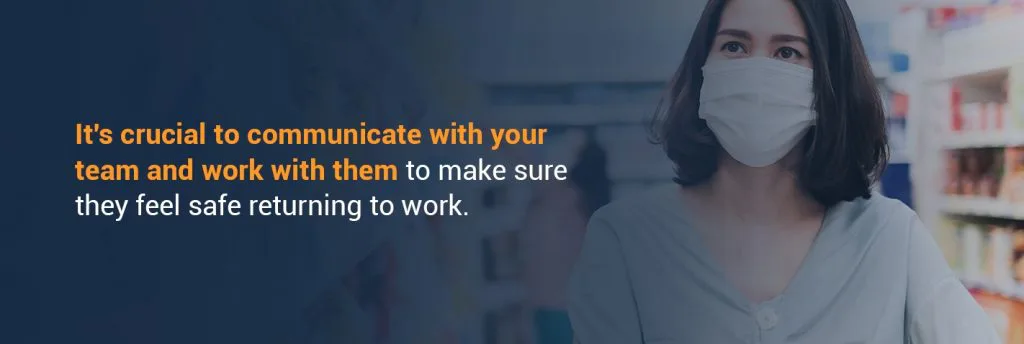
Even after following all the necessary guidelines, you may have to do more to get your business up and running. Staff may be fearful about returning to work, and customers may be worried about venturing out for nonessential services. It’s crucial to communicate with your team and work with them to make sure they feel safe returning to work. For customers, highlight the precautions your business is taking and ask if there is anything you can do to make them feel safer.
As an employer, you need to support and train your employees to protect themselves, each other and your customers. Here’s what you can do to prepare your employees for a return to work:
With all the new guidelines to keep workplaces and customers safe from coronavirus, it’s crucial to ensure everyone is following them. Employees should receive training as appropriate on:
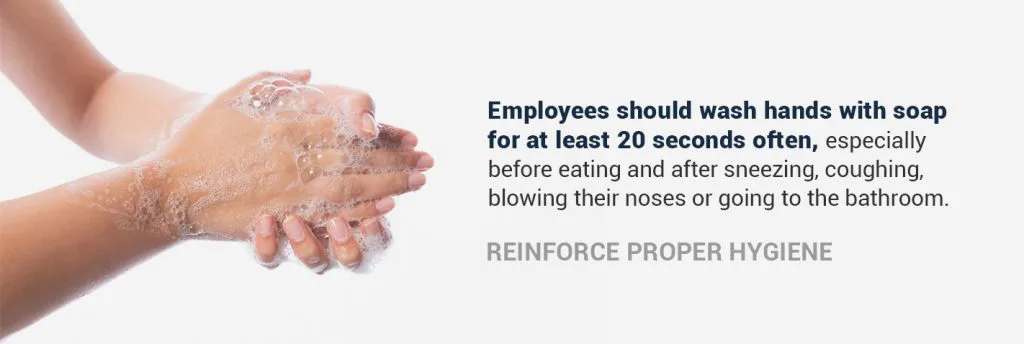
When handling food items as you would in a restaurant or grocery store, you need to follow hand-washing guidelines. Employees should wash hands with soap for at least 20 seconds often, especially before eating and after sneezing, coughing, blowing their noses or going to the bathroom.
The Food and Drug Administration (FDA) has more personal hygiene guidelines for food service workers. They recommend employees use gloves to avoid direct contact with ready-to-eat foods. Your staff should also wash their hands before preparing food.
As an employer, you can reinforce these behaviors through frequent reminders, informational posters in the bathrooms and by providing access to gloves and soap. Place hand sanitizing stations throughout your store or restaurant to help employees stay sanitary between hand washings.
Another way to support employees is by offering flexible sick leave. The CDC recommends employees stay home when they feel sick to prevent the spread of germs to other employees and customers. To accommodate that, employers should be flexible with sick leave and understand an employee might need to take more sick time.
If you have employees who split their time between several locations or who frequently travel to meet with suppliers, consider limiting this travel. Keep employees at a single site and, whenever possible, hold virtual meetings.
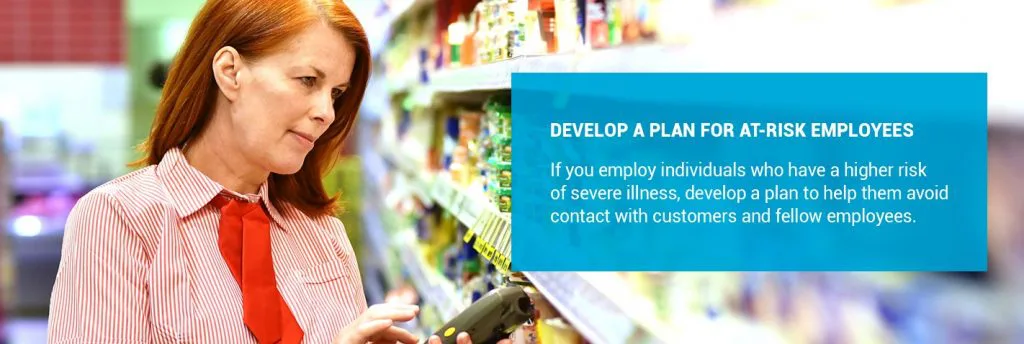
When handling food items as you would in a restaurant or grocery store, you need to follow hand-washing guidelines. Employees should wash hands with soap for at least 20 seconds often, especially before eating and after sneezing, coughing, blowing their noses or going to the bathroom.
The Food and Drug Administration (FDA) has more personal hygiene guidelines for food service workers. They recommend employees use gloves to avoid direct contact with ready-to-eat foods. Your staff should also wash their hands before preparing food.
As an employer, you can reinforce these behaviors through frequent reminders, informational posters in the bathrooms and by providing access to gloves and soap. Place hand sanitizing stations throughout your store or restaurant to help employees stay sanitary between hand washings.
Another way to support employees is by offering flexible sick leave. The CDC recommends employees stay home when they feel sick to prevent the spread of germs to other employees and customers. To accommodate that, employers should be flexible with sick leave and understand an employee might need to take more sick time.
If you have employees who split their time between several locations or who frequently travel to meet with suppliers, consider limiting this travel. Keep employees at a single site and, whenever possible, hold virtual meetings.
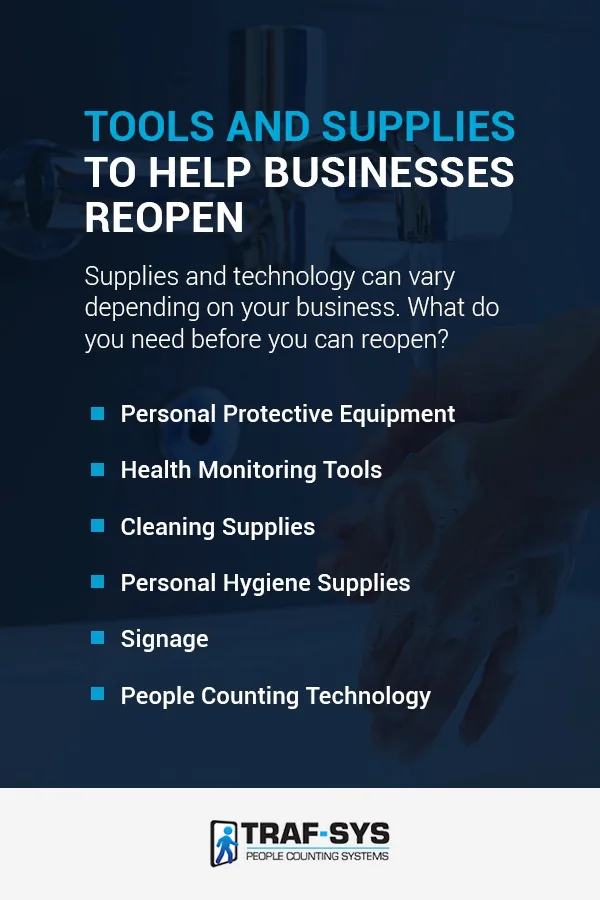
What do you need before you can reopen? Supplies and technology can vary depending on your business, so you should review this list to see what tools might be helpful.
With social distancing rules lowering building capacity for many businesses, a reliable way to know how many people are in your store or restaurant is to use an occupancy counter. The technology, which can be either infrared, image processing or thermal-based, senses when people enter or exit your building to give you an accurate headcount. You can then safely enforce lowered capacity requirements. A people counter helps you meet coronavirus guidelines, with high-precision real-time reporting on combined IN and OUT data from unlimited entry points. A customer-facing display can also provide your customers with helpful information about the current occupancy levels before entering. We developed the SafeEntry system to meet the demands of the current COVID-19 crisis. It displays the number of patrons that are “safe to admit” at any time, lets you set your own capacity limits and uses no additional hardware.
Personal protective equipment can take different forms for different businesses. They often include disposable masks and gloves for employees. If you can provide these accommodations to your employees, hold training on how to wear them. If your employees wear cloth face coverings, provide support and directions for how to wash them. They should be washed and dried at the highest temperature settings after every use.
In a retail setting, you can also consider using plexiglass partitions at registers.
Non-contact infrared thermometers or thermal cameras can be used to check employee and customers’ temperatures upon arrival. If your business can afford to use temperature monitoring, it can go a long way in preventing sick people from visiting your store.
The EPA has a list of disinfectants approved for use against SARS-CoV-2 and other viral pathogens. Look for disinfectants from this list first. You can mix your own disinfectant with either 1/3 cup of bleach and 1 gallon of water or 70% alcohol if you cannot find any. If you need to disinfect a soft, porous material such as carpet or upholstered seating, you’ll need a specific disinfectant for these materials.
Besides disinfectants, you should have gloves, soap and water for cleaning surfaces throughout your business.
You should try to set up hand sanitizing stations for both customers and employees, especially at cash registers or where people come in contact with one another. They should also be set up near where employees handle food or merchandise. Also, be sure the restrooms are well-stocked with soap and paper towels, so employees and customers can wash their hands. Other personal hygiene supplies include tissues and no-touch trash cans.
You might consider posting signage around your business to remind customers and employees to keep an appropriate distance and wash their hands often. You can also mark the floor with tape to keep tables and people at least 6 feet apart.
With social distancing becoming the new normal for the foreseeable future, your store needs live occupancy counting to keep up. As your employees learn new procedures and you take on new responsibilities to keep customers safe, automated people counting offers many advantages.
With new restrictions placing maximum occupancy limits at a fraction of what they usually are, it doesn’t take many people for your building to reach its maximum occupancy. To maximize the number of people you can serve without violating rules, up-to-the-minute data about how many visitors you have is crucial. SafeEntry from Traf-Sys offers a real-time count that any of your employees can access via phone, tablet or computer.
If your store has multiple entrances, IN and OUT foot traffic is instantly updated for all employees without any additional coordination. Employees can update the occupancy limit at any time, allowing you to adjust as restrictions do. If you’re reserving certain hours for high-risk visitors, you can lower your occupancy limit during this time for added protection.
Counting people by hand puts your team is closer proximity with more of your customers, which can make your employees feel unsafe. It also requires at least two people per door if one person counts those who enter and another counts those who leave. With the coronavirus placing additional duties, such as disinfecting, on your staff’s docket, you might not have the capacity to divert many of your employees to counting customers. People counting sensors automate this task, allowing you to send your staff where they are needed most.
Some of your customers may want to avoid shopping during peak times. However, with people working fewer or more flexible hours, daily rushes can be more unpredictable than they have been in the past. If you use a monitor to display a current occupancy count for customers, people can decide for themselves whether it is safe to enter. Your customers will appreciate knowing your business is doing one more thing to keep them safe. You may even see your crowds self-regulate, with more people choosing to come back another time.
Knowing how many people visit your establishment on a given day can help you adjust your cleaning and disinfecting decisions. You might decide you want to clean your building after a certain number of people have entered or by looking at occupancy data over time.
For example, say your people counter registers a regular peak in visitors between 12 p.m. and 2 p.m., and a lull at 3 p.m. You can use this information to close at 3 p.m. for routine cleaning then reopen before your evening rush. With data-backed decision making, you can maintain cleanliness without sacrificing business.
Keeping the workplace safe in the age of coronavirus can be a challenge. It’s new territory for every business owner, and that leaves many questions about how to stay safe.
With many companies following new rules and seeing fewer customers than usual, it can be challenging to bring in new business. Here are a few things your business can try to attract new customers:
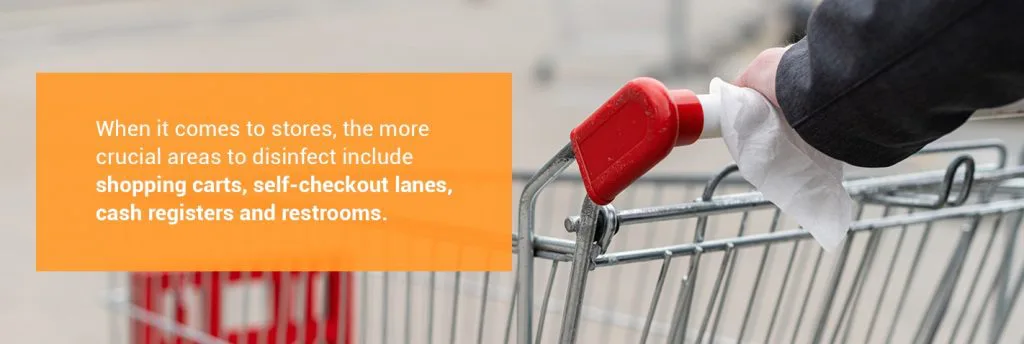
Currently, the CDC does not recommend that shoppers or stores disinfect food products. There’s no evidence that food packaging plays a significant role in spreading COVID-19 in the U.S. When it comes to stores, the more crucial areas to disinfect include shopping carts, self-checkout lanes, cash registers and restrooms.
Have employees wash their hands before stocking items and discourage shoppers from touching products they don’t intend to buy. For other types of merchandise, such as clothes, some stores are using a 72-hour “quarantine” for returned items.
In a restaurant setting, the FDA recommends some new procedures to keep food safe for consumption:
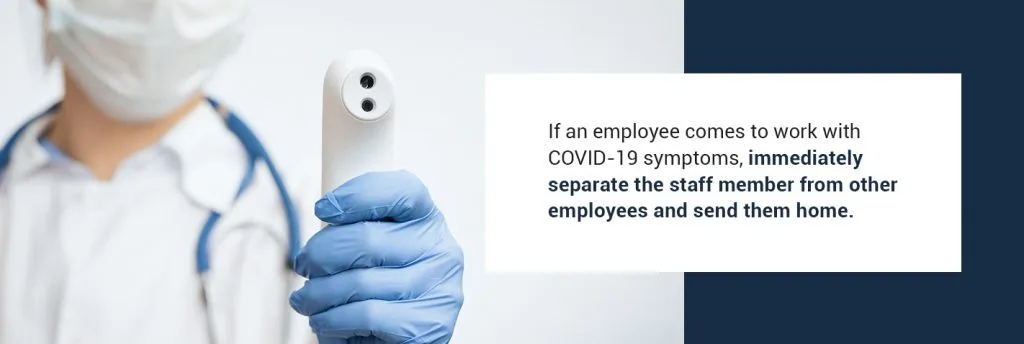
If an employee comes to work with COVID-19 symptoms, immediately separate the staff member from other employees and send them home.
According to the CDC, if an employee has a confirmed or suspected case of COVID-19, you probably do not need to shut down the entire facility. However, you should close off any areas used for a prolonged period by the sick person. Wait at least 24 hours or as long as possible before cleaning and disinfecting to minimize the risk of exposure to respiratory droplets. During the waiting period, increase air circulation to the contaminated area by opening outside doors and windows.
Follow all CDC guidelines to disinfect the area. Determine which employees may have been exposed to the virus and decide what precautions those individuals should take. If the employee has a confirmed case of COVID-19, employers should inform employees of possible exposure without violating workplace confidentiality.
People counting technology can help if you need a way to limit capacity in your retail store or restaurant. We offer a wide range of people counting sensors that allow you to access real-time data on the number of people in your store without the need for an employee at the door. Our systems offer 95% accuracy and above, with detection zones up to 80 feet wide.
We offer a variety of tools to help you regulate the capacity of your store. Customer-facing screens inform visitors whether they can enter and allow each customer to make an informed decision before entering your establishment. The technology reduces the workload for your essential workers and shows customers you care about their safety.
Learn more about how our people counters work or request a quote today.